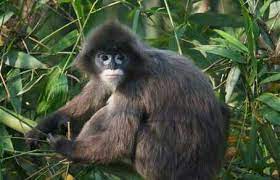Tripura is known for its diverse flora and fauna. The state animal of Tripura is the phayre’s langur, also known as the spectacled langur. In this article, we’ll take a closer look at the phayre’s langur and its significance to Tripura.

The phayre’s langur is a medium-sized primate that is found in Southeast Asia, including northeastern India. It has distinctive markings around its eyes, which resemble spectacles, giving it its common name. The langur has a dark gray or black fur coat, with a white belly and long tail. The species is arboreal, spending most of its time in trees and feeding on leaves, fruits, and flowers.
In Tripura, the phayre’s langur is considered a sacred animal and is revered by the indigenous tribes of the state. The langur is an important cultural symbol and is believed to bring good luck and prosperity. It is also associated with the forest and is seen as a guardian of the natural environment.
Unfortunately, like many other wildlife species in India, the phayre’s langur has been threatened by habitat loss, hunting, and other human activities. The species is listed as vulnerable on the International Union for Conservation of Nature (IUCN) Red List of Threatened Species. Conservation efforts are underway to protect the langur and its habitat in Tripura and other areas where it is found.
The state government of Tripura has also taken steps to protect the phayre’s langur. The species is protected under the Wildlife Protection Act, and hunting or trading of the langur is strictly prohibited. The government has also established wildlife sanctuaries and national parks to protect the langur’s habitat.
In conclusion, the phayre’s langur is an important animal in Tripura’s cultural and ecological heritage. As a sacred animal, it holds a special place in the hearts of the people of Tripura. Efforts to protect and conserve the langur are crucial for the survival of the species and the preservation of the natural environment. By working together, we can ensure that the phayre’s langur continues to thrive for generations to come.
Important Links